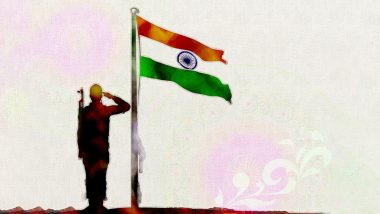National Flag adoption day of India is celebrated every on July 22. The National Flag Adoption Day is observed to create awareness among the Indians about the Indian flag. The day also commemorates the sacrifice of our great freedom fighters for making India a free nation. India became independent on August 15, 1947. National Flag Adoption Day 2019: Significance and History of the Tricolour or Tiranga, India's National Flag
The National Flag was designed by Pingali Venkayya. It was first adopted on July 22 in 1947 adopted by the Indian Constitution Assembly and became the official flag of the Dominion of India on August 15, 1947. The National Flag of India is a horizontal rectangular tricolour with Saffron on top, white in the middle and Green at the bottom. The Ashoka Chakra is also inscribed on the white stripe with 24 spokes. Know How To Hoist, Take Down and Dispose of The Tricolour According to the Flag Code of India.
Interesting facts about Tricolour:
- The idea of a single Indian flag was first raised by the British rulers of India after the revolution of 1857 having western heraldic standards design.
- Mahatama Gandhi first proposed a Tricolour flag to the Indian National Congress in 1921 with spinning wheel inscribed on the white strip.
- In the initial flag designed by Venkayya, there was a spinning wheel, instead of the Ashoka Chakra.
- Initially, Venkayya was told to design a flag with a spinning wheel on colour Red (for Hindus) and colour Green (for Muslims) on it.
- The Tricolour was first hoisted on April 13, 1923 by Congress workers in Nagpur, during a procession to protest the Jallianwala Bagh Massacre.
- In the flag adopted by the ad hoc committee formed by the Constituent Assembly on June 23, 1947, the spinning was replaced by the Ashoka Chakra.
- Finally on July 22, 1947, the first Prime Minister of India, Pandit Jawaharlal Nehru proposed before the assembly the horizontal Tricolour with colour saffron, white and green on the flag in equal proportion and Ashoka wheel in blue printed on the white space in between.
- Tiranga became the flag of the Republic of India on January 26, 1950.
- All the Tricolours are made out of khadi cloth of silk or cotton. The standards were created in 1968 and were updated in 2008.
- Currently, Karnataka Khadi Gramodyoga Samyukta Sangha based in Hubli is the only licensed flag production and supply unit in India.
Sarvepalli Radhakrishnan, the second President of India had explained the significance of national flag. According to him: "the Saffron denotes renunciation or disinterestedness. Our leaders must be indifferent to material gains and dedicate themselves to their work. The white in the centre is light, the path of truth to guide our conduct. The green shows our relation to (the) soil, our relation to the plant life here, on which all other life depends. The "Ashoka Chakra" in the centre of the white is the wheel of the law of dharma."
(The above story first appeared on LatestLY on Jul 22, 2019 07:00 AM IST. For more news and updates on politics, world, sports, entertainment and lifestyle, log on to our website latestly.com).













 Quickly
Quickly


